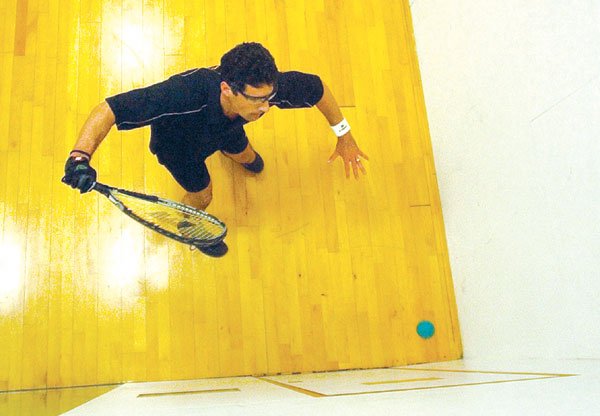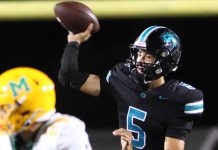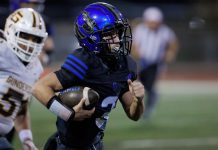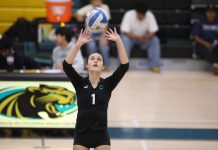Gilroy
– Five months ago, Ricardo Espinoza was just starting to get
competitive in racquetball, a sport he had played recreationally
for years. In January, the 28-year Gilroy resident played in his
first two tournaments and did well. In February, Espinoza took off
for his native Peru to visit family for
a month.
This is where the story gets interesting.
Gilroy – Five months ago, Ricardo Espinoza was just starting to get competitive in racquetball, a sport he had played recreationally for years. In January, the 28-year Gilroy resident played in his first two tournaments and did well. In February, Espinoza took off for his native Peru to visit family for a month.
This is where the story gets interesting.
While in Peru, Espinoza, 36, came across Jose “Pepe” Schaefer, Peru’s top racquetball player for over 20 years.
Schaefer, 46, who was the South American singles champion in 1990 and the seniors champion (for players over 35) in 1994, hadn’t competed for five years.
“I’d always remembered Pepe as the one who represented Peru,” recalled Espinoza.
The two hit it off. Schaefer, who had trained many players at the “Open” level (the highest amateur level), was interested in getting back into playing.
“I wanted to come (to the U.S.) and get to a better level,” said Schaefer, with Espinoza interpreting. “Up here, players can really push me and I want to take advantage of that.”
Schaefer also wanted to revive the sport of racquetball in Peru, which hadn’t been represented at the racquetball World Championships since Schaefer stopped competing. He wanted Espinoza to be part of that, if he was up for it.
“You’ve got a lot of talent. You could start representing Peru,” Schaefer told Espinoza.
“What?” Espinoza said. He’d only played in two tournaments, but none at the Open level. Nevertheless, he agreed, and figured under the right guidance he’d be ready for competition in a couple years. But Schaefer had other plans.
“No, I think you’d be an Open player in six months,” he said.
Earlier this month, Schaefer arrived in Gilroy to train. Now, he and Espinoza play at least three times a week, with their sights set on representing their native country of Peru at the Senior World Championships at the end of August.
Strangely, this isn’t the first time Espinoza has decided to start pursuing a sport competitively at a time in his life considered past-prime.
For a long time, Espinoza, whose love for sports drove him to open Gilroy’s Planet Fitness gym in May 2004, was a soccer player. He moved to Gilroy from Lima, Peru when he was 8 and grew up in the Gilroy school system. In high school, he played soccer for Gilroy High, but never cracked the starting line-up.
Still, he enjoyed the sport and continued playing in college at Cal-Poly San Luis Obispo at the intramural level. It wasn’t until after college, at a time when most serious players are winding down their careers, that Espinoza decided he wanted to seriously pursue soccer.
“Maybe it’s just the way I’m built, but after college, I said, ‘I really want to take this to the next level,'” Espinoza said. He started playing for some semi-pro clubs in the San Francisco area alongside many players who eventually went on to play in the MLS. While practicing one day, Espinoza and another player were approached by the coach of the San Jose Grizzlies of the Continental Indoor Soccer League (CISL). The coach told the two players that they should sign up for the CISL supplemental draft. They did, and Espinoza was picked up by the San Diego Sockers.
But Espinoza’s dream of playing pro got cut short when the CISL folded shortly after the draft.
“My big break was receiving the piece of paper that says, ‘You’ve been drafted,'” Espinoza joked. But the experience stuck with him.
“It was very interesting,” said Espinoza about coming back to the area and playing against former teammates and players who had gone on to play college soccer. “Now I was running circles around them. It was very surreal. Now I’m trying to do the same with racquetball.”
Before Schaefer arrived from Peru, Espinoza began taking lessons from Gene Pare, a certified racquetball instructor from Campbell, who himself has won medals in Open level championships both nationally and internationally.
Originally, Pare was giving lessons to Espinoza’s friend and playing partner Mario Esteves. For years, Espinoza couldn’t beat Esteves.
“Finally, Mario told Ricardo that he’d been working with me,” Pare laughed, “Ricardo called me up and wanted to take some lessons. Now Ricardo’s been beating him ever since.”
Under the guidance of Schaefer and Pare, Espinoza is becoming a well-rounded racquetball player. When Pare first met Espinoza, he saw a player that knew a lot of the basics and was physically fit and athletic. What mostly needed tweaking was his playing strategy.
“What I wanted to do was work on his mental aspects of the game,” Pare said. “He wasn’t doing the right things with the ball. You can hit it as hard as you want. It’s still going to end up in the middle of the court.”
Schaefer, Espinoza said, is helping him with his attacking game so he can be ahead of his opponents.
Pare said that Espinoza will have some tough competition in international play, but that he has the right mentality to help him deal with that.
“A lot of people want lessons, but they want to tell you what they want to do,” Pare said. “Ricardo is an open book and he’s willing to do everything I’ve said he needs to do.”
The ultimate goal for Espinoza and Schaefer are the World Open Championships in July of 2006. If that goes well, they could go on to the Pan-American Games, which happen next in the spring of 2007.
“That’s so cool,” gushed Espinoza mid-sentence while taking about the Pan-Am Games. The late-blooming athlete never dreamed he might have a chance to participate in the Games, let alone in racquetball after the age of 36.
“I’m just here for the ride,” Espinoza said. “It won’t have mattered how I did at these games. Just the fact I was there to represent (Peru) is enough. … Because (the U.S.) is such a powerhouse in every sport, the odds are so far against you.”
Pare thinks Espinoza’s and Schaefer’s chances of representing Peru in the Pan-Am games are good, even though they don’t really have a chance of beating the world’s best players. But they could have success, like some other underdogs.
“They can be like the Jamaican bobsled team,” Pare said.
For Schaefer, just having the opportunity to train in the U.S. alone is a big deal. Schaefer was elated when Espinoza, who is sponsored by racquetball equipment and clothing company E-Force, presented him with new gloves, racquets and a bag. Back in Peru, Schaefer had been practicing with two racquets – one that had a broken string – that were several years old, Espinoza said. Still, he became a champion.
“He comes from a small town where there’s only one racquetball court and very few players. He had no real competition,” Espinoza said. “He became the South American champion and No. 1 playing on that court by himself.”
Now, Espinoza has a shot at being a champion as well.














